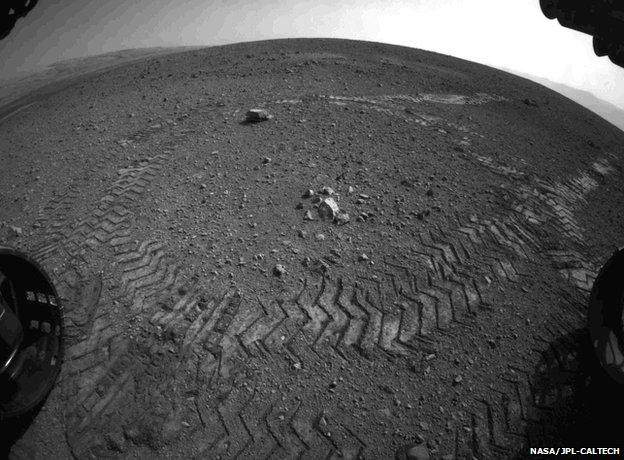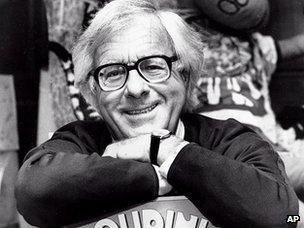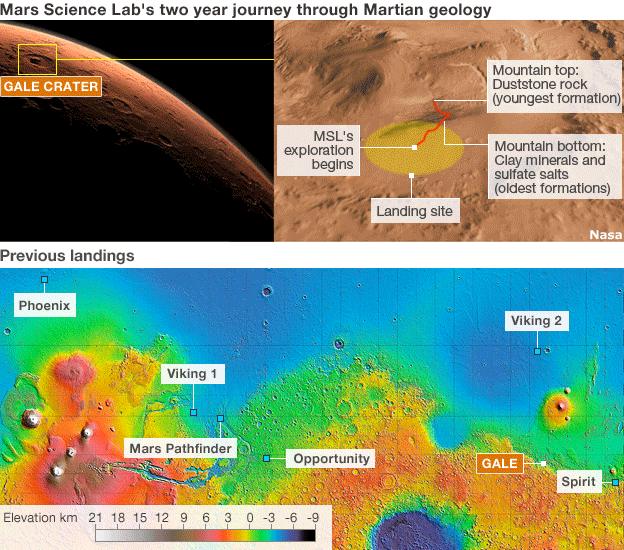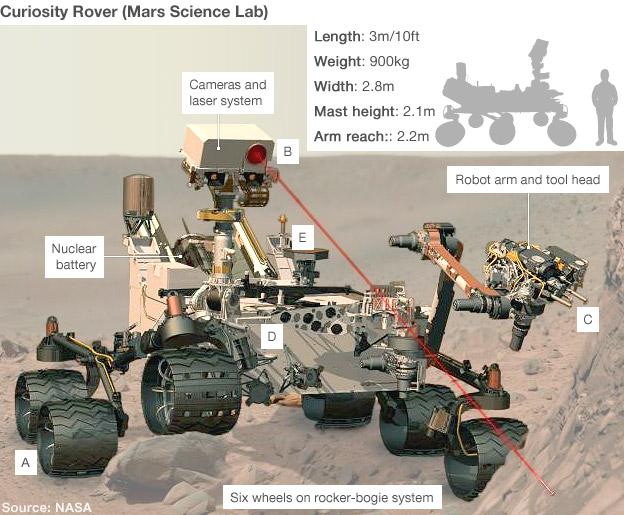Curiosity Mars rover takes first drive
- Published

Driving off Bradbury Landing: The tracks left in the Martian soil by the rolling Curiosity vehicle can be seen at top-right
The US space agency's (Nasa) Curiosity rover has finally begun to roll.
The Mars robot, which landed on the Red Planet two weeks ago, turned its six wheels briefly on Wednesday to satisfy engineers that its locomotion system was in full working order.
Curiosity, external is a sophisticated mobile science laboratory.
It has been built to drive at least 20km across the Martian landscape to investigate whether the planet ever had the conditions necessary for life.
Wednesday's drive saw the rover roll forward 4.5m, turn clockwise on the spot for about 120 degrees, and then reverse up 2.5m.
It took about five minutes to complete the manoeuvre. Another 10 minutes or so was spent taking pictures of the outcome, recording the vehicle's historic first tracks in the Martian soil.
Nasa's Matt Heverly: "I'm pleased to report that today Curiosity had her first successful drive on Mars"
Looking at those images, which have been stitched together to make the mosaic featured on this page, it is clear now that Curiosity's rear-right wheel landed on top of a rock estimated to be some 9cm tall.
The vehicle will cover a lot of ground on this mission but the significance of the first roll manoeuvre could not be overstated, said Curiosity project manager Pete Theisinger.
"It couldn't be more important. We built a rover and unless the rover roves, we really haven't accomplished anything," he told reporters.
"And the fact that we completely exercised it and everything was on track is a big moment."
Nasa has made one other key announcement on what has been the 16th day of this mission. It has named the spot on which the robot landed after the science fiction author Ray Bradbury, external.
The celebrated American writer, who died in June, was an enthusiastic supporter of the space agency.
"His books have truly inspired us," said Michael Meyer, the lead scientist on Nasa's Mars exploration programme. "The Martian Chronicles, external have inspired our curiosity and opened our minds to the possibility of life on Mars.
"In his honour, we declare the place that Curiosity touched down to be forever known as Bradbury Landing."

Having rolled forward a few metres, Curiosity rotated on the spot about 120 degrees
The rover is now pointing southwest in the general direction of Mount Sharp, the big mountain at the centre of Mars' equatorial Gale Crater.
Scientists expect to find rocks at the base of the peak that were laid down billions of years ago in the presence of abundant water.

Ray Bradbury was an enthusiastic supporter of Nasa and its projects
Curiosity - also known as the Mars Science Laboratory, MSL - will not journey to Mount Sharp immediately, however. The mission team first wants to visit a piece of ground some 400m to the east, a location the researchers have dubbed Glenelg.
Satellite pictures have shown this place to be an intersection of three distinct types of rock terrain. Scientists think it will be a good place to start to characterise the geology of Gale Crater.
The rover will probably set off for Glenelg in about a week, following some science investigations of Bradbury Landing itself and a number of additional practice drives.
On its way to the intersection, Curiosity will likely scoop a soil sample to examine in its onboard laboratories.
"When we finally get to Glenelg, we want to study the outcrop there and take a look at the contacts between the three different terrain types," said Joy Crisp, a deputy project scientist on the mission.
"Maybe there is where we'll decide to do our first drilling into rock. And after Glenelg, we head for Mount Sharp. That's going to take several months."


(A) Curiosity will trundle around its landing site looking for interesting rock features to study. Its top speed is about 4cm/s
(B) This mission has 17 cameras. They will identify particular targets, and a laser will zap those rocks to probe their chemistry
(C) If the signal is significant, Curiosity will swing over instruments on its arm for close-up investigation. These include a microscope
(D) Samples drilled from rock, or scooped from the soil, can be delivered to two hi-tech analysis labs inside the rover body
(E) The results are sent to Earth through antennas on the rover deck. Return commands tell the rover where it should drive next
Jonathan.Amos-INTERNET@bbc.co.uk and follow me on Twitter, external
- Published7 June 2012
- Published21 August 2012
- Published20 August 2012
- Published20 August 2012
- Published17 August 2012
- Published14 August 2012
- Published13 August 2012
- Published11 August 2012
- Published9 August 2012
- Published9 August 2012
- Published8 August 2012
- Published7 August 2012
- Published7 August 2012
- Published6 August 2012
- Published6 August 2012
- Published4 August 2012